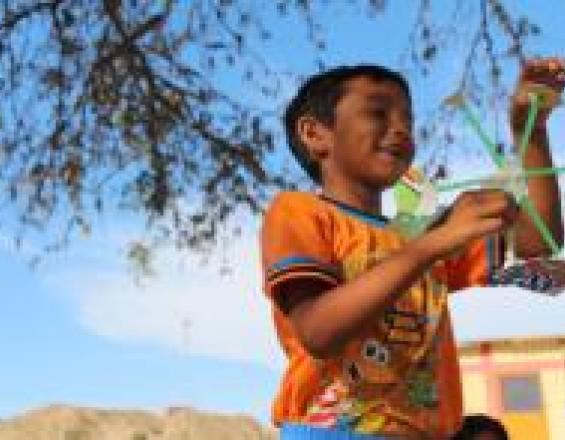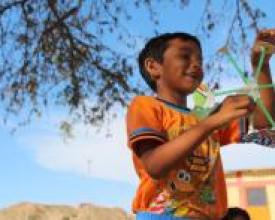ConCiencia – Conservation through Love //Guerilla Environmental Education
Full Solution

ConCiencia
ConCiencia
We work with locals to form closer bonds and vigilance over nature by creating nature camps in different locations.
We include fun, purposeful family activities. Children and parents form the confidence to spend time in nature and explore.
By developing teaching resources and collaborating with schools, we can slowly insert immersive nature experiences in curriculum. It is important to have changes in policy to scale this kind of education approach.
Last update: 02 Oct 2020
3719 Views
Context
Challenges addressed
need for increased environmental awareness
Location
Peru, coast
South America
Process
Summary of the process
Start out using Human-Centered Design helps us to create appropriate programs for each situation. Multidisciplinary teams help us to do this by contributing varied points of view. By following the students’ interest we makes sure that the interests of our main beneficiary is met and education is working for them. By having a quick production and delivery of these programs, we can evaluate their success and make the adjustments necessary without losing an big investment of time and resources.
Building Blocks
Human-Centered Design
Human-Centered Design
1) Human-centered Research: Collect insights about the situation and location, the community’s and children’s needs and wants.
2) Create: lesson plans and learning project ideas on site, with a multidisciplinary team.
3) Deliver our ideas watchful of how the children react and continually modifying the lessons to fit the students’ interests and situations that emerge.
Enabling factors
Human Capital – large, multidisciplinary teams
-Horizontal – every team member has equal voice
-Full immersion – live in the location
- Listen and research – Enter a location with humility and ready to learn
-Extract key insights
-Ask why to get to the root causes of the behaviors you wish to impact
Depth over scope – try to get to know people, especially at the extremes of a certain attitude or situation
Lesson learned
-Leave assumptions at the door. We all carry cultural baggage and to be effective outside our particular community, we have to recognize them.
- Listen to everyone, from children to community leaders, each has a wealth of insight.
- -Don’t be afraid to make mistakes. Sometimes you learn the most from them.
- -Make sure the whole design team understands the process or it can be confusing to lack a clear structure.
- -Unify your message. Many times lining out tone and language can be very important, as well as rules and expected behavior.
Resources
Multidisciplinary teams
Engage varied professionals in teaching. Our core team is backed by a rotating cast of varied professionals and locals such as architects, photographers, musicians, surfers, fishermen and all type of artists. Varied point of view help discover different education potential from a lesson or activity in nature.
Enabling factors
A collaborative atmosphere where everyone contributes attracts talented professionals.
The challenge to work in education is interesting to many great professionals.
Working towards a common goal, sharing ideologies, benefits, and ownership.
Short options make it accessible to many professionals.
Rotative leadership
The opportunity to spend time in nature is a huge plus.
Lesson learned
The group should help each professional design their activity or project, find the educational potential in their specialty or interest, define roles, agree on how to structure the project or activity, and do a run through.
-Manage expectations. All parties must know what they offer and need from each other.
- Rehearse activities and scope out terrains before including children in the mix.
- Maintain a strong dynamic by engaging in fun leisure activities.
- -Always take time to explore and engage with nature. Do sports, share laughs, cook dinner.
- Make sure to provide clear information about: a) daily structures and “rituals”, b) class management, c) safety procedures d) vocabulary and attitudes we wish to convey, e) lesson plans.
Student-driven learning
Follow students’ interests. Bring students to sites in natural and protected areas and observe where their interests lead them. We seek educational potential in the aspects that captivate the group.
Enabling factors
- High adult to child ratios allow us freedom
-Being outside of school requirements allows us to be open to change lesson plans to follow students’ interests.
-Children propose the topic and we can discover together how it works.
- An opening and closing discussion to point out the scientific or educational application of the activity is useful.
- Children to speaking up about their observations can open up new topics of discovery.
Lesson learned
-Observe group dynamics and capitalize on them: in nature many times students that are generally quiet or overlooked have a chance to stand out for a particular sensitivity, encourage this.
-Bring attention back to students with rituals, such as a song, dance or call.
-Closing circles at the end give us a moment to reflect on the day’s excitement and tie it back to the concepts.
Crowdsource education
Create channels for different members of the community to participate in teaching by sharing their experiences, guiding outings and contributing insight.
Enabling factors
-Everyone knows something interesting about nature and life. Each student, community member, guest.
- Being outside, community members can easily join us.
-
- Being welcoming and curious and find those who have engaging stories or perspectives to share.
Lesson learned
It has been very important for our work as a travelling initative to hold our lessons in public spaces to earn the trust of the communities (many of these are very small and not used to outsiders). -Everyone has something to offer if they feel inspired to. Create a safe atmosphere, where everyone feels appreciated and wants to share. -Treat everyone with respect.
Impacts
-90% of students increased their comprehension on 70% of the ecological concepts explored through our 5-week program.
-1 of 2 students report spending more time in nature several months after the program
-1 of 5 students report picked up litter in family outings several months after the program
- 80% of parents report a change in environmental attitudes in their children
Beneficiaries
Children (gain skills, quality of life and develop stewardship), adults (gain quality of life)
Story
Lao Tze wrote: ““Go to the people. Live with them. Learn from them. Love them. Start
with what they know. Build with what they have. But with the best
leaders, when the work is done, the task accomplished, the people will
say 'We have done this ourselves.”
We need to make sure that the doors are open for children to enjoy and reap their education and development from nature. The research consistently shows that time in nature, especially in childhood, correlates to pro conservation behavior and beliefs.
